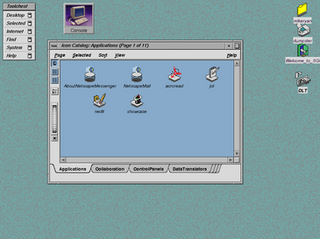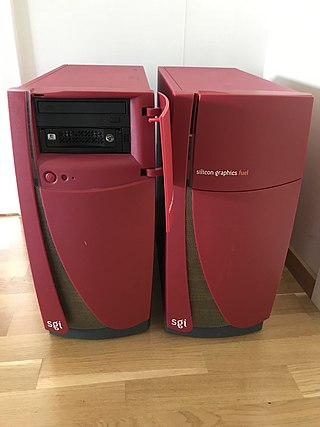Overview
68000
Silicon Graphics Computer Systems' first product, shipped in November 1983, was the IRIS 1000, a terminal with hardware-accelerated 3D graphics based on the Geometry Engine developed by Jim Clark and Marc Hannah at Stanford University. As a terminal, it was not intended for standalone use, and was instead attached to a VAX-11 running VAX/VMS or Unix. It was soon followed by the IRIS 1200, another terminal with a larger backplane, [1] before the IRIS 1400 emerged as SGCS's first standalone workstation in 1984. [2] The processor used in these early systems, the 'PM1', was a variant of the SUN (Stanford UNiversity) processor, and sported a Motorola 68000 (or 68010) clocked at 8 MHz. With the IRIS 2000 series (released in 1985) came SGCS's first internally-designed processor, with a Motorola 68010 running at 10 MHz. The final Motorola 68000-based series, the 3000s released in 1986, were built around a 68020 running at 16 MHz. [3] These systems ran the GL2 operating system, a predecessor of the IRIX operating system, which is based on UniSoft UniPlus System V Unix. [4] GL2 uses a proprietary (and highly rudimentary) windowing system named mex (Multiple EXposure). [5]
MIPS

Beginning in 1987, SGCS began selling workstations with MIPS RISC processors rather than the Motorola 680x0. These new systems adopted a different numbering scheme, with the prefix '4D/' followed by a two-to-three digit number. The first of these systems was the 4D/60 'Professional IRIS', sporting a MIPS R2300 clocked at 8 MHz in a unique 'twin-tower' case, with the cardcage being within the larger tower on the left, and the power supply and drives being kept within the smaller tower on the right. The right tower could come in different heights to support larger quantities of storage. Like the IRIS 1000 series which preceded it, the 4D/60 did not use an internally designed processor board, instead using a generic MIPS systems board (likewise, the earliest versions of the new operating system for the MIPS-based workstations, dubbed '4D1', was largely derived from MIPS' own RISC/OS).
In 1988, SGCS superseded the Professional IRIS line with the higher-end PowerSeries line (specializing in Symmetric Multi-Processing, and so-named for its proprietary POWERpath architecture), and the lower-end Personal IRIS line. The PowerSeries systems came in a number of configurations, with anywhere between 1 and 8 processors and coming in either a twin-tower chassis akin to the Professional IRIS, a mini-fridge sized desk-side chassis (code-named 'Diehard'), or a full rack-sized chassis (code-named 'Predator'). One could determine the processor count of a PowerSeries system from its model number - the second digit would directly indicate the number of CPUs, so a 4D/210 would have one processor, a 4D/340 would have 4 processors, etc. The PowerSeries was ultimately eclipsed, first by the 64-bit MIPS R4000-based IRIS Crimson, and then by the POWERpath-2 based Onyx and Challenge series. [6]

The Personal IRIS line consisted of four main models - the 4D/20, /25, /30, and /35. The /20 and /25 were both released in 1988, with the /30 and /35 debuting in 1990. With an entry price of £10,300, the Personal IRIS was Silicon Graphics' cheapest workstation. [7] The 4D/35 would later be cost-reduced into the IRIS Indigo, released in 1991, which was so architecturally similar to the 4D/35 that it shared the same Internal Processor ID (IP12) in software. [8]
Beginning in late 1992 with the release of the Indigo² and Challenge, the 'IRIS' prefix would be dropped from the names of all future systems, as well as the '4D/' model numbers. The '4D1' operating system would be re-branded as 'IRIX' beginning in version 3, as well. However, all future MIPS-based systems released by Silicon Graphics would still use 'IRIS' as the default hostname, ending with the Tezro in 2003.
Human Interface Devices
A unifying feature across all IRISes – 68K, Professional, Personal, PowerSeries, Indigo, Crimson, and Onyx – is a proprietary serial-based keyboard/mouse protocol. Earlier machines use either a DE-15 (68K, Professional, PowerSeries) or DE-9 (4D/20, /25) connector, with the later machines (4D/30, /35, Indigo, Crimson, Onyx) using a mini DIN-6 which is easy to confuse with a standard PS/2 connector. One must take care not to insert an IRIS keyboard into a PS/2 port or vice versa, as the voltage levels used in the two protocols are incompatible and may result in damage to the keyboard, computer, or both. An easy method to determine if a Silicon Graphics keyboard is PS/2 or not is to check whether or not the mouse plugs in to the keyboard - the IRIS protocol, similar to Apple's Apple Desktop Bus and Sun's own serial keyboard/mouse protocol, daisy-chains the mouse and keyboard together. [9]











